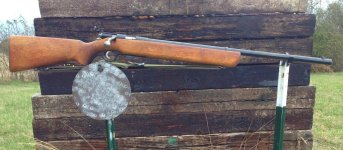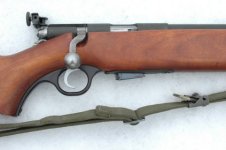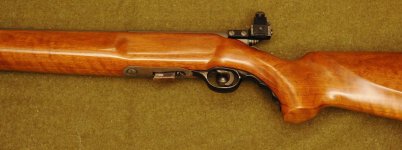Faulkner
Well-known member
I seem to recall I got this information from the CMP about 15 years ago when I ordered my first of several Mossberg 44US training rifles. I bought one for me and one each for both of my sons and they learned how to shoot early in age with one of these very accurate rifles. I took one out to the range this weekend and was again impressed with how accurate it is, I love the military style peep sights on these rifles.
History of Mossberg 44US
The 44US target trainer was designed exclusively for the war department, and intended solely for use by U.S. troops. O.F.Mosssberg had filled orders for almost 58,000 units from 1943-1945, with another 19,000-plus rifles scheduled but not shipped due to contract cut-backs and cancellations near the end of World War II.
The 44US was adapted from the pre-war 44B model, and, like the 42MB, the adaptations were mostly made to keep costs down. Ordnance wanted an accurate, dependable, heavy-barreled trainer, and sacrificed some cosmetic detail to make it affordable. While the 44B featured a deluxe, genuine walnut stock with long beavertail and cheek piece, the 44US stock was plain, usually birch with walnut finish. The plain S-122 front sight was requested, and the government wanted a new receiver peep sight - rejecting the No. 4. While Harold Mossberg was busy designing this new sight for the United States, the first batch of 14,500 went out with Lyman 57MS receiver peeps. The heavy barrel was manufactured utilizing a lead-lapped process that is used today only on the most expensive target rifles.
The United States Armed Forces continued to train with the Mossberg 44US target .22 after the war, using supplies in Ordnance from these contracts, and some rifles may be found with branch markings, such as U.S. Navy and some Coast Guard trainers stamped U.S.C.G. The Navy continued its training with Mossberg target .22s for over four decades, commissioning a Model 144US in later contracts (1949-1960) and used both in active service training and at Naval Junior ROTC academies. The United States Air Force and U.S. Army also acquired the later 144US, and as late as 1989, Rock Island Arsenal reported a total of 3,552 of these models in current stock. Approximately 2,500 of these were still in active use, primarily as trainers. Government nomenclature designates these rifles as either "M13" grade (training rifle) or "M12" grade (match use).
Specifications for Model 44US (Military)
• Manufactured between 1943 and 1949.
• 7 Shot Detachable Box Magazine
• Weight 8 Lbs.
• Rear Sight – Mossberg micrometer click receiver peep.
• Barrel: 13/16 heavy-type, 26” long with crowned muzzle, chambered for .22 cal. long rifle
• Target Stock, Military walnut-finish oiled stock with front and rear sling swivels.
• Bolt Action
• Overall Length 43 ¼ inches
• US PROPERTY marked on barrel, receiver
• Rifles with serial numbers 14,500 through 138,921 were produced in 1943. Serial numbers 139,922 through 165,648 were produced in 1944. Serial numbers 165,649 through 177,948 were produced in 1945.

History of Mossberg 44US
The 44US target trainer was designed exclusively for the war department, and intended solely for use by U.S. troops. O.F.Mosssberg had filled orders for almost 58,000 units from 1943-1945, with another 19,000-plus rifles scheduled but not shipped due to contract cut-backs and cancellations near the end of World War II.
The 44US was adapted from the pre-war 44B model, and, like the 42MB, the adaptations were mostly made to keep costs down. Ordnance wanted an accurate, dependable, heavy-barreled trainer, and sacrificed some cosmetic detail to make it affordable. While the 44B featured a deluxe, genuine walnut stock with long beavertail and cheek piece, the 44US stock was plain, usually birch with walnut finish. The plain S-122 front sight was requested, and the government wanted a new receiver peep sight - rejecting the No. 4. While Harold Mossberg was busy designing this new sight for the United States, the first batch of 14,500 went out with Lyman 57MS receiver peeps. The heavy barrel was manufactured utilizing a lead-lapped process that is used today only on the most expensive target rifles.
The United States Armed Forces continued to train with the Mossberg 44US target .22 after the war, using supplies in Ordnance from these contracts, and some rifles may be found with branch markings, such as U.S. Navy and some Coast Guard trainers stamped U.S.C.G. The Navy continued its training with Mossberg target .22s for over four decades, commissioning a Model 144US in later contracts (1949-1960) and used both in active service training and at Naval Junior ROTC academies. The United States Air Force and U.S. Army also acquired the later 144US, and as late as 1989, Rock Island Arsenal reported a total of 3,552 of these models in current stock. Approximately 2,500 of these were still in active use, primarily as trainers. Government nomenclature designates these rifles as either "M13" grade (training rifle) or "M12" grade (match use).
Specifications for Model 44US (Military)
• Manufactured between 1943 and 1949.
• 7 Shot Detachable Box Magazine
• Weight 8 Lbs.
• Rear Sight – Mossberg micrometer click receiver peep.
• Barrel: 13/16 heavy-type, 26” long with crowned muzzle, chambered for .22 cal. long rifle
• Target Stock, Military walnut-finish oiled stock with front and rear sling swivels.
• Bolt Action
• Overall Length 43 ¼ inches
• US PROPERTY marked on barrel, receiver
• Rifles with serial numbers 14,500 through 138,921 were produced in 1943. Serial numbers 139,922 through 165,648 were produced in 1944. Serial numbers 165,649 through 177,948 were produced in 1945.
Attachments
Last edited:





